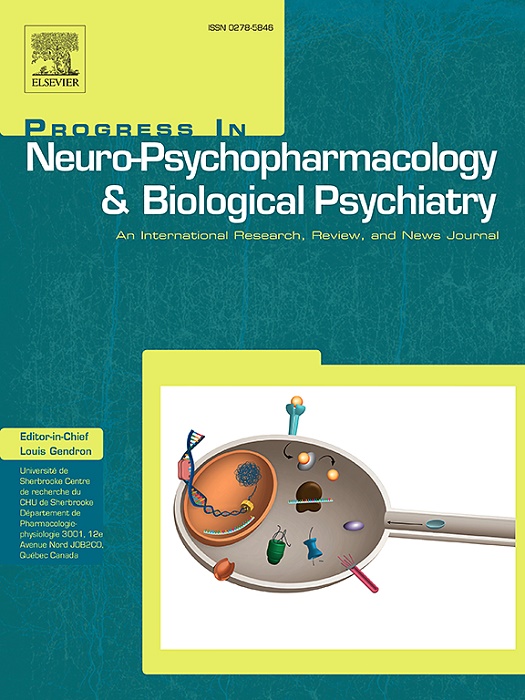Sexual dimorphism of white-matter functional connectome in healthy young adults
IF 3.9
2区 医学
Q1 CLINICAL NEUROLOGY
Progress in Neuro-Psychopharmacology & Biological Psychiatry
Pub Date : 2025-09-08
DOI:10.1016/j.pnpbp.2025.111486
引用次数: 0
Abstract
Background
Sexual dimorphism in human brain has garnered significant attention in neuroscience research. Although multiple investigations have examined sexual dimorphism in gray matter (GM) functional connectivity (FC), the research of white matter (WM) FC remains relatively limited.
Methods
Utilizing resting-state fMRI data from 569 healthy young adults, we investigated sexual dimorphism in the WM functional connectome. We constructed both WM-WM and GM-WM FC networks and subsequently analyzed their FC strength, functional connectivity density, and network topological properties. Based on identified dimorphic features, a radial basis function support vector machine model was employed for sex prediction and classification. Validation analyses confirmed the reproducibility of our findings.
Results
Our analyses revealed significant sexual dimorphism in FC within both the WM-WM and GM-WM networks. Notably, females generally exhibited stronger connection strengths across numerous pathways compared to males. Topologically, females displayed greater global system aggregation (higher clustering coefficient) in the WM-WM network. Similarly, within the GM-WM connectome, females showed enhanced network integration, specifically higher global and local efficiency in the frontoparietal network and increased clustering coefficient in the attention network. Critically, these dimorphic WM features proved effective for sex classification using machine learning; an integrated model combining WM-WM and GM-WM FCs achieved superior predictive performance over models using individual feature sets, highlighting the unique information encoded in WM functional dynamics.
Conclusion
This finding extends our understanding of brain sex differences beyond gray matter and provides novel insights into the neurological mechanisms potentially underlying sex-specific patterns in cognition, behavior, and susceptibility to brain disorders.
健康青年白质功能连接体的两性二态性。
背景:人类大脑性别二态现象在神经科学研究中引起了极大的关注。尽管许多研究已经研究了灰质(GM)功能连接(FC)的性别二态性,但对白质(WM) FC的研究仍然相对有限。方法:利用569名健康青年的静息态fMRI数据,我们研究了WM功能连接组的两性二态性。我们构建了WM-WM和GM-WM FC网络,并随后分析了它们的FC强度、功能连接密度和网络拓扑特性。在识别二态特征的基础上,采用径向基函数支持向量机模型进行性别预测和分类。验证分析证实了我们研究结果的可重复性。结果:我们的分析显示,在WM-WM和GM-WM网络中,FC存在显著的性别二态性。值得注意的是,与男性相比,女性通常在许多途径上表现出更强的连接强度。在拓扑结构上,女性在WM-WM网络中表现出更大的全局系统聚集性(更高的聚类系数)。同样,在GM-WM连接组中,女性表现出增强的网络整合,特别是额顶叶网络的整体和局部效率更高,注意网络的聚类系数更高。关键是,这些二态WM特征被证明对使用机器学习进行性别分类是有效的;结合WM-WM和GM-WM fc的集成模型比使用单个特征集的模型具有更好的预测性能,突出了WM功能动态中编码的独特信息。结论:这一发现扩展了我们对大脑性别差异的理解,超越了对灰质的理解,并为认知、行为和大脑疾病易感性中潜在的性别特异性模式的神经机制提供了新的见解。
本文章由计算机程序翻译,如有差异,请以英文原文为准。
求助全文
约1分钟内获得全文
求助全文
来源期刊
CiteScore
12.00
自引率
1.80%
发文量
153
审稿时长
56 days
期刊介绍:
Progress in Neuro-Psychopharmacology & Biological Psychiatry is an international and multidisciplinary journal which aims to ensure the rapid publication of authoritative reviews and research papers dealing with experimental and clinical aspects of neuro-psychopharmacology and biological psychiatry. Issues of the journal are regularly devoted wholly in or in part to a topical subject.
Progress in Neuro-Psychopharmacology & Biological Psychiatry does not publish work on the actions of biological extracts unless the pharmacological active molecular substrate and/or specific receptor binding properties of the extract compounds are elucidated.

 求助内容:
求助内容: 应助结果提醒方式:
应助结果提醒方式:


